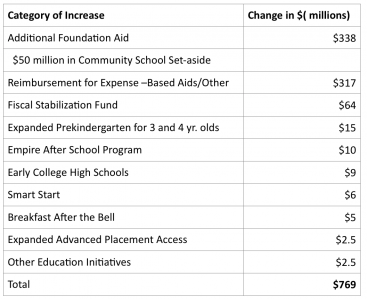Governor Cuomo’s Proposed Budget
Governor Cuomo’s opening remarks introducing his budget proposal stressed the unique and challenging aspects of this year’s state budget. This year’s budget is impacted by economic losses, devastating federal policies, and pending legal issues. Taken summatively, these factors will require New York to clearly define its priorities and get ahead of as many of the hurdles as possible.
An area that will be of particular interest to school leaders is the governor’s focus on ensuring that state funding be targeted to the “poorest” school districts. This topic was mentioned in his State of the State address and again today in his budget address. The prevailing thinking on this issue seems to be that if the state is directing funding to the poorest districts, that there should be some onus on the part of districts to ensure that state funding is directed to the “poorest” schools. The governor included a few more specifics in today’s address by proposing that districts submit plans indicating how funding will be directed to each school in the district. A similar type of accountability is required in ESSA and included in the proposed ESSA state plan as part of the reporting requirements for federal funding streams by school.
The governor set the context of his budget proposal by stating that the education budget constitutes the largest segment of the state budget and has seen a 36 percent cumulative increase since 2012. According to his data, New York is #1 in the Nation in terms of spending per pupil.
The FY 2019 proposes:
- An overall increase of $769 million in state aid
- An increase in Foundation Aid of $338 million
- $15 million for prekindergarten expansion
- $10 million for after school programs
- An increase of $50 million for community schools

- Prekindergarten funding will focus on high-need districts not currently serving 3 and 4 year olds. The funding will be used to promote integrated and community based settings. The QualitystarsNY rating system will continue to receive $5 million.
- Full-day kindergarten funding will be provided for some remaining districts that did not yet receiving funding for such conversion.
- The second round of Empire After School programs will focus on districts with high rates of homelessness. Two million dollars will be targeted to high risk communities to deter potential gang activity or involvement.
- The Early College High Schools funding will support 15 new programs to provide opportunities to earn college credit while in high school.
- Six million dollars for the Smart Start program will be focused on expanding high quality computer science and engineering education. Grants will support teachers with resources and professional development.
- Funding categorized as “other education initiatives” will include banning lunch shaming, supporting breakfast programs after the school day has begun, expansion of the Farm to School program, and increased use of locally grown foods at schools.
- Alignment of charter school funding with public school spending.
- A 3 percent increase in aid to nonpublic schools for state-mandated programs.
- Alignment of state reimbursement of summer school special education programs with wealth-equalized aid ratio used to during the school year.
- One million dollars to expand the Master Teacher Program.
- Gang prevention education programs will receive $1.5 million of over 3 years.
- Funding ($400,000) for a third round of Empire State Excellence in Teaching Awards.
- Authorization of BOCES non-component districts (including the Big 5) to participate in Recovery High Schools.
- A proposed 2 percent cap on major expense based aid categories.
Prior to addressing his education fiscal priorities the governor laid out a series of tax reforms that SAANYS will carefully monitor as more details on these actions become known. For more information on the proposed budget please feel free to contact Cindy Gallagher at cgallagher@saanys.org or 518-782-0600.